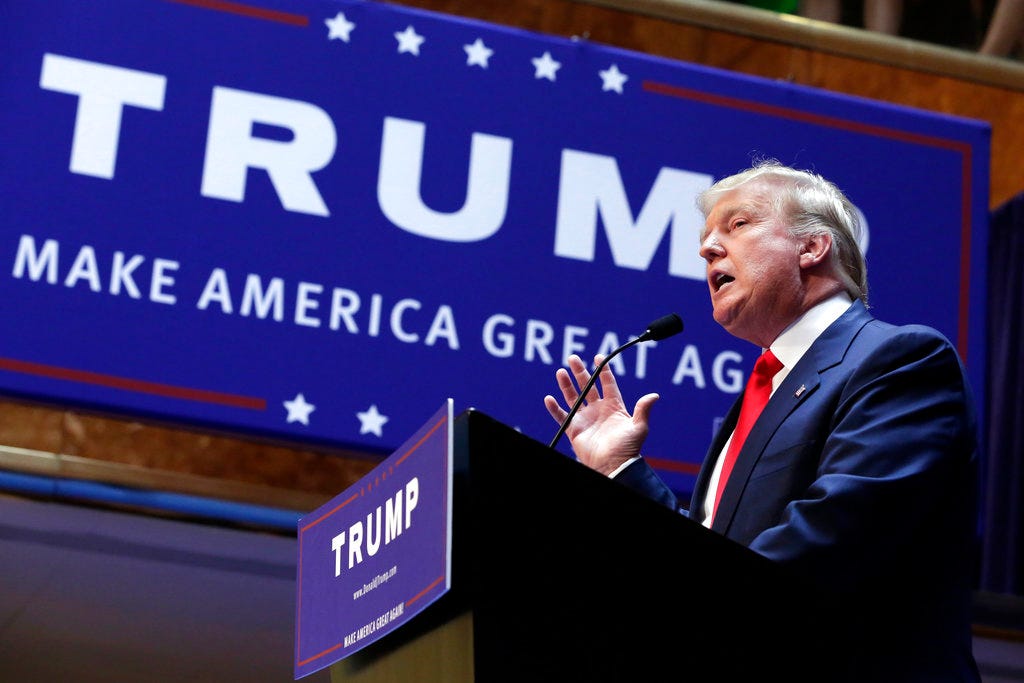
AP Photo/Richard Drew, File
- Trump was "unsure" if his views would attract a "following" at the outset of his first campaign.
- The former president told correspondent David M. Drucker that he was simply speaking his mind.
- "I felt strongly about it – and it wasn't Republican," he said of his 2016 campaign agenda.
Even out of the White House, former President Donald Trump continues to have a firm grip over the Republican Party, with top allies and legions of grassroots supporters anxiously awaiting a 2024 campaign, fueled by their desire for his outside-the-box governing that they felt defied the norms of Washington, DC.
Trump regularly boasted sky-high approval ratings among Republicans throughout his presidency. Even out of office, he attracts devoted followers, who have held on to the conservative political messaging from his campaign's earliest days, to rallies across the country.
However, after the launch of the former president's 2016 campaign, he was unsure if his political views would help him connect with a substantial number of Republican voters, as chronicled by Washington Examiner senior political correspondent David M. Drucker in his new book, "In Trump's Shadow: The Battle for 2024 and the Future of the GOP."
While Trump previously teased presidential campaigns going back to the 1980s, it wasn't until 2015 that he officially leapt into the political sphere – with almost universal name identification from his international business brand and his longtime stint on NBC's "The Apprentice" – and honed in on a strategy of appealing to disaffected voters.
When Trump launched his 2016 campaign, he critiqued his Republican rivals for focusing on theoretical conservative values and not paying enough attention to the needs of voters.
"I hear their speeches, and they don't talk jobs and they don't talk China," he said during his kickoff speech. "People are saying: 'What's going on? I just want a job. Just get me a job, I don't need the rhetoric. I want a job.'"
That spontaneous messaging, which strayed from the original version of the speech, immediately hooked in many Republicans and conservative-leaning independents.
Trump told Drucker during an interview at his Mar-a-Lago club in Florida that he "quickly" wrote the original version of the speech, but thought it needed more of a punch, hence his forceful salvo.
"When I was delivering it, I felt it wasn't nearly strong enough," he said.
Drucker goes on to explain how Trump's strategy succeeded, as he ramped up support in rural communities across the country, especially in the Midwest, gaining steam among Americans who voted infrequently and conservatives who had lost faith in many traditional Republican politicians.
"It's taken for granted now, that of course it worked. That Trump recognized, intuitively, strategically, perhaps both, that voters in Rust Belt battleground states whom Republicans had been losing for decades, in places like Michigan, Pennsylvania, Wisconsin, and elsewhere, were just waiting around for a conservative populist like him to come along," Drucker wrote. "That Trump just knew bashing China would work; that the United States post-Cold War - that the Republican Party, of all parties, post-Cold War - was looking inward and just waiting for a presidential candidate to come along and promise protectionism, quasi-isolationism, borders closed to legal and illegal immigrants."
"Trump would eventually classify this agenda as 'America First,' a phrase discredited generations ago as nativist, xenophobic, and unbecoming a great power that embraced its role as the leader of the free world. But in the beginning of his first campaign, Trump was unsure that any of his unorthodox notions would attract a significant following. They never had before," he added.
As the 2016 race approached, the country was increasingly polarized and less wedded to embracing traditional politicians.
Trump's in-your-face message scrambled the race and elevated his candidacy.
"I felt strongly about it - and it wasn't Republican," the former president told Drucker. "Basically, it was what I thought."